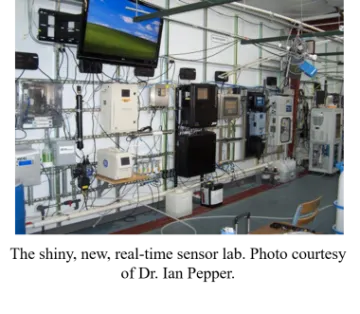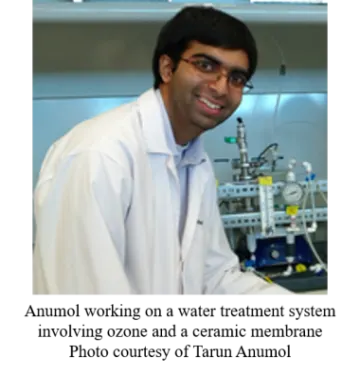When water is scarce, management has to be smart and technology must be resilient.
Since 1926, when Grand Canyon National Park began recycling its wastewater, Arizona has established a reputation for developing innovative reclamation technology. The latest advancement: a state-of-the-art water reclamation campus in Tucson. The WEST Center, opened in November 2015, creates a pipeline of possibilities for industry-university partnerships, cutting-edge research, and time-sensitive technological advancements.

“I see the WEST Center as the focal point for inland water re-use in the United States. We have state-of-the-art facilities and a campus with more than 300 people who study water in different ways,” said Dr. Shane Snyder, WEST Center co-director and professor at the University of Arizona (UA). “This unique project advances the stature of the state and the region, and positions us as an essential part of the global water hub.”
When Pima County began developing plans for a water reclamation campus in coordination with its new wastewater facility, it turned to the UA’s Dr. Ian Pepper and Snyder to head up a university presence. Pepper, who co-directs the WEST Center with Snyder, had long worked alongside the county, while Snyder, prior to his work at the UA, led a research and development team for the Southern Nevada Water Authority.
Even before converging at the WEST Center, Pepper and Snyder were working with private industry and public utilities on water treatment and reuse. Snyder focuses on water treatment engineering and chemical contaminant monitoring technologies, while Pepper studies biological contaminants and sensor systems. It’s fitting that when describing WEST Center activities and the coming together of experts like UA professors, their students, Pima County, the City of Tucson, and leading companies from the private sector, Snyder likes to use the word “synergy”.
“The WEST Directors, along with diverse faculty, students, and staff from across the campus, create a powerful team capable of addressing grand challenges in water and energy sustainability,” Pepper said. As a sage and timely example, Dr. Chuck Gerba of the UA is a world-renowned microbiologist who recently won a large, multi-million-dollar grant from the US Department of Agriculture (USDA) to investigate pathogens in irrigation water, a project that will heavily rely on the unique infrastructure at the WEST Center.
Changes in climate, population growth, and urbanization are exacerbating water shortages and limiting supplies throughout the Western USA and around the world: innovate and comprehensive approaches to wastewater recycling are an important component for addressing these challenges. Though few facilities in Arizona turn wastewater effluent to drinking-ready water, technology developed at the WEST Center could soon make direct-potable reuse a statewide reality.
At the WEST Center’s core, there’s synergy, and there’s imminence. “It looks imminent to me that Arizona will have to embrace more water recycling. I don’t personally, or scientifically, see any other options,” Snyder said. “The WEST Center allows us to bring a diverse group of people together to try and tackle some of the greatest issues we face as a country, particularly in this part of the country.”
TRANSFORMATIVE TECH
Alongside prominent expertise, these pioneering technologies push the WEST Center to the forefront of reclamation innovation:
- Cutting-edge technology that pumps wastewater effluent directly into the WEST Center for scale-relevant testing. “The high bay technology demonstration area offers the ability to mimic real-world events and treatment processes, and to arrange and rearrange the treatment train order to test the efficacy, efficiency, and reliability of the system—and that’s a big deal,” said Pepper.
- A unique, real-time sensor lab where scientists can test for chemical and microbial contaminants during water treatment and within water distribution systems, offering what Pepper called “a fail-safe system” that can detect contaminants before people get sick.
- Additional WEST Center lab space enables comprehensive water quality evaluations, including: molecular studies, microbiology, aquatic toxicology, analytical chemistry. The facility also includes purpose-built laboratories for alternative energy research and improvements for water treatment systems that lowers electrical energy demands, such as novel biological treatment systems.
Drawn by the expertise and leading-edge technology, private companies like Dow Chemical, Calgon Carbon, SC Johnson, Biological Detection Systems (BDS), and Agilent Technologies have signed on as founding members of the WEST Center. Dr. Jeff Prevatt, Regulatory Compliance Manager for Pima County, said: “we want people who are looking at bringing direct effluent to drinking water to come to us to work together for advancement of novel technologies and applications.”
For Pepper and Snyder, the fact that students can test advanced technologies with these companies in a brand new lab is one of the greatest perks. The WEST Center currently supports more than 20 graduate students in gaining real-world and industry-relevant experience.
“My own students are being hired by the very companies involved. Who knows that technology and equipment better than the student who has been working with it?” Snyder said.
STUDENT SUCCESS

UA graduate Tarun Anumol tested a new product that Agilent Technologies—founding WEST Center industry member—deemed critical for analyzing organic contaminants in wastewater. A lab to beta test the technologies was essential to their efforts, and because of Snyder’s reputation, they chose the WEST Center. Anumol focused on testing the equipment and communicating with Agilent employees to resolve issues and report findings. His active engagement translated to a prompt job offer from Agilent when he graduated.
“I finished my PhD and let my colleagues at Agilent know I was graduating. My experience collaborating with them and my familiarity with their projects made me a very competitive candidate,” Anumol said, now nearly a year into his work as an applications chemist at Agilent.
The experience, funds and connections Bradley Schmitz gained conducting his PhD research at the WEST Center gave him the unique qualifications he needed for a postdoctoral fellowship at the National University of Singapore (NUS)—ranked in the top 15 for world universities, and the same University where Snyder has served as a visiting Professor for over five years. Schmitz studied the effectiveness of modern technologies at removing viruses, which will likely be regulated by the EPA in the future, and said that the WEST Center/Pima County collaboration was essential for the success of his work. The ultimate goal, Schmitz said, is to bring his knowledge and expertise back to the Grand Canyon State:
“Water is arguably the most important resource in the world, and that understanding is strong in Arizona. Being able to apply my knowledge toward something that would greatly impact people in the place I call home would be a phenomenal opportunity.”

